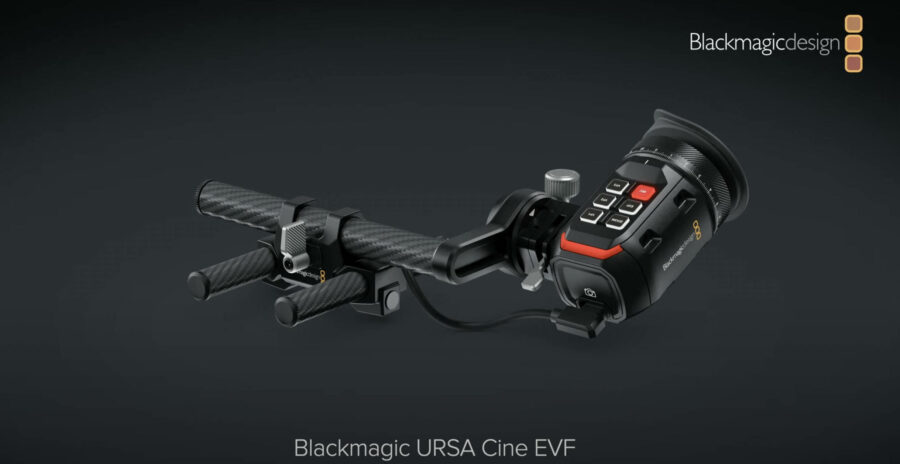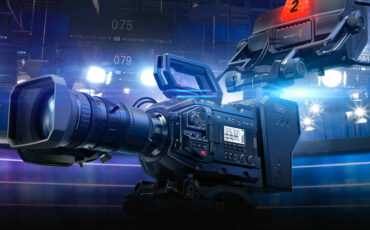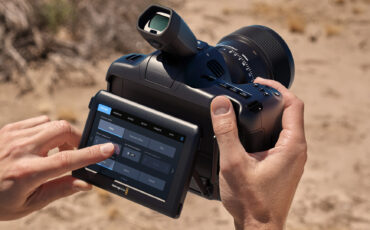Blackmagic URSA Cine 12K LF Announced – 12K Full-Frame Sensor, Open-Gate 3:2, New 8TB Dedicated Recording Module
The URSA Mini line of cameras is finally getting the full-frame treatment. Ever since Blackmagic Design announced the Blackmagic Cinema Camera 6K full-frame version last year it was just a question of time until their higher-end cameras would be getting the bigger sensors, too.
And that time has come: the Blackmagic Design URSA Cine 12K LF has been announced just in time for NAB 2024 – and Blackmagic Design has some major claims for it, e.g., 16 stops of dynamic range (a number we will surely be testing in our lab very soon!).
According to the company, it has been designed for high-performance filmmaking, working with cloud applications, serving multi-cam film shoots, and working in the “Volume”. The company analyzed each component of the previous URSA Mini 12K model (Super35 sensor), down to the screws used to see if they fit the purpose.

“We wanted to build our dream high end camera that had everything we had ever wanted. Blackmagic URSA Cine is the realization of that dream with a completely new generation of image sensor, a body with industry standard features and connections, and seamless integration into high end workflows. There’s been no expense spared in designing this camera and we think it will truly revolutionize all stages of production from capture to post!”
Grant Petty, CEO Blackmagic Design
Apart from a new sensor, the camera has some very interesting features that Johnnie and Nino dive into in our video – check it out to see what they make of this new release.
Here is a rundown of all the specs and technical details:
Fully new 12K full-frame sensor
The 12K full-frame sensor has been newly designed and measures 35.64×23.32 mm. The pixel size has grown in comparison to the Super 35mm sensor previously found in the URSA 12K model. Blackmagic Design claims 16 stops of dynamic range for the sensor. We will be putting this to the test in our lab as soon as we get our hands on this camera and share with you how it went.

The camera can handle up to 120 fps in 12K/2.4:1 widescreen aspect ratio, or 100 fps at 12K/17:9. 12K 3:2 open gate will allow recording at 80 fps.
If even a higher-frame rate recording is needed for your production, 8K 2.4:1 widescreen recording in 228 fps can be utilized.
Open gate recording without any crop in 12K 3:2, 8K 3:2, and 4K 3:2 is also possible. All recording formats on the camera will support anamorphic de-squeeze at ratios of 1.3, 1.5, 1.6, 1.66, 1.8, or 2 times.
Here are some of the recording options available:
- 12K Open Gate 3:2 (12K x 8K) @ 80 fps
- 12K 17:9 (12 x 6K) @100 fps
- 12K 2.4:1 widescreen (12K x 5K) @ 120 fps
- 9K 3:2 and 6:5 Super 35mm 4-Perf
- 9K 17:9 and 16:9 Super 35mm 3-perf
- 9K 2.4:1 Super 35mm 2-perf
- 8K Open Gate 3:2 @ 144 fps
The native ISO is 800, it is not a dual-native ISO sensor. According to Blackmagic Design, this allows for higher dynamic range.
Below you can find a detailed list of sensor specs:

New proprietary 8TB recording module
Blackmagic Design has created a new proprietary recording module for their camera. It is made from NVMe mounts slotted into four high data rate PCIe lanes and has a capacity of 8TB. The recording module can stay in the camera since the URSA Cine 12K LF has Blackmagic Design’s cloud storage integrated into it. This means that if the camera is connected via the 10G Ethernet or WiFi, anyone with access can see the data as it is being recorded. Clips become available and can be worked on as soon as they have stopped recording on the camera.
Blackmagic Design will also be offering a dock for the recording module. As soon as it is plugged in, the recording module will automatically become a Cloud store and be accessible via the Blackmagic Cloud. You can also connect the camera directly to your computer via an Ethernet to Thunderbolt adaptor. You can then open the IP address of the camera in your browser and access the stored data this way.
There will also be separate CFexpress recording modules available in the future. Proprietary technology often draws criticism from users, but Blackmagic Design argues that the new recording module allows for faster writing speeds – therefore opening new recording possibilities and making it future-proof. Other variants (CFexpress, external SSDs, etc.) present speed bottlenecks and will therefore have limited choices when it comes to codecs and frame rates.
Interestingly enough, this 8TB NVMe recording module will be included in the camera kit!
New EVF
The new EVF features soft-touch backlit buttons that can be customized by the user. Using turnbuckles, the EVF can be exchanged and manipulated without tools for quick changes in the configuration. It is connected to the camera via a USB-C cable and can be used with other devices. (Yet to be tested with some other cameras).
The Beginner’s Guide to DaVinci Resolve

The viewfinder will be sold separately with mounting accessories. An extension piece for the viewfinder, which is compatible with standard eyepiece levelers, for work on a dolly will also be available.
Built-in WiFi and ND filters
The camera comes with built-in WiFi which allows for streaming directly from the camera. You also have the possibility to stream proxies locally. The Blackmagic Design URSA Cine 12K LF also has built-in electronically controlled ND filters for 2, 4, and 6 stops.
Hardware and connectors
The camera comes with a PL mount installed, but there is also a locking EF mount included in the kit. At a later stage, there will also be the possibility to order an LPL mount version. The mount can be shimmed separately.
It is equipped with two tripod mounting options for 19mm (standard) and 15mm rails. A unique locking mechanism allows for the camera to be taken quickly and effortlessly off the tripod plate. This makes changing from tripod to aerial or handheld shooting situations easy.

The camera has three LCD monitors: one small monitor on the outside left which displays settings, timecode, and other information. It can be folded out to give access to a 5” high-res LCD touchscreen monitor. It is rotatable by over 90° and can be folded back into the camera with the larger display on the outside. On the right-hand side of the camera there is another 5” touch screen display (which cannot be rotated). Both monitors have features such as a live view of lens data (focus and aperture), which can be sent out to the focus puller, and can be addressed individually. Focus stops can also be set and removed via the touch screen.
Here is a list of all the connectors that can be found on the new camera:
- Three independent 12G SGI connections allow you to send out two signals (e.g. a clean feed and one with an overlay of the lens info) as well as time code and synchronization.
- A 10G Ethernet port, which will enable new features, such as editing directly from the camera when it is connected to a DaVinci Resolve station, in the future.
- A locking 8-pin LEMO connector at the back for a 12V or 24V connection to power the camera and all connected accessories.
- The camera is shipped with a B-mount now, but more battery mounting solutions are planned (although the V-mount option might come with some caveats such as lower frame rate recording limits).
- Just above the battery mount, there is a 2-pin LEMO connector for 12V output for further accessory power. Further at the top are two XLR connectors for your audio inputs.
- The camera has three connectors at the front: a USB-C connector (which was used to plug in the EVF in our demo but will also be able to output to external recording devices in the future)
- A 3-pin RS connector for a remote control
- A 7-pin locking LEMO connector for powering and control accessories such as lens motors or monitors. Both the RS and LEMO connectors provide 24V power out and have two amps between them.
- Two further USB-C connectors are at the top right-hand side of the camera. These are protected with rubber covers.
New silent backlit soft-touch buttons are built into the sides of the camera, the buttons on the older URSA Mini model were mechanical and made a clicking noise which could be distracting on set.
Pricing and availability
The camera will be delivered in a custom Pelican case (with custom foam inlay) with the included accessories. It is priced at $14,995 for the set without the EVF (but including the 8TB memory recording module, top handle, top rod mount, WiFi antennas, B-mount plate, and 19mm base plate), and $16,500 for the kit including the EVF. The EVF alone will set you back about $1,695. Blackmagic Design expects to ship the camera to customers around the middle of May.
What do you think about this camera? Are you a focus puller happy to get your own dedicated screen? What other features do you find useful? Let us know in the comments below!































